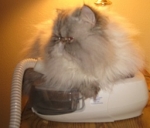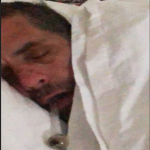DreamStalker wrote:
Sorry Joy ... your reference is wrong or misleading.
E. Coli is about 2,000 nanometers
Rhinovirus is about 20 nanometers
Water molecule is 0.278 nanometers
It is physically impossible for an object to hitch a ride on an airborne object 100 times smaller ... no can do. It would be like you trying to hitch a ride on a bumble bee. And if you were an E. Coli, it would be like you trying to hitch a ride on a nat
Well, my research was done 31 years ago , and now I have brain damage from long-term undiagnosed OSA . . . but I stand my ground nonetheless
Here's the deal, my cute little monkey friend:
Your stats on Rinovirus & E. coli are correct. Instead of nanometers (nm) . . . I usually use microns (same as micrometers) and abbreviated "µm". Rhinovirus 0.02 µm (or 20 nm) and E. coli 2 µm long (2,000 nm). However E. coli is spread by contact. The types of bacteria usually transported via droplets or water vapor aggregates are smaller, as small as 0.2 µm.
HOWEVER, We are NOT talking about transmission on "a water molecule". We are talking about water droplets (100-500 µm), and droplet nuclei (2-5 µm). A droplet of water vapor consists of "10 to the 11th power" or more water molecules. It is basic knowledge in microbiology that no researcher would dispute, whether environmental or clinical (especially in the hospital environment or surgical stage) that airborne bacteria are transported via water droplets, aerosols, hygroscopic droplet nuclei.
Now how all that relates to our discussion of CPAP humidifiers is not something I'd swear to, but it seems like one could make some applications that would at least seem to make sense. After all, there is a fan blowing air over the water, and that might form a kind of aerosol that would doubtless carry some microbes with it (assuming it's contaminated). We're dealing with a humidified environment, so the droplet or aggregate of water molecules mixed with microbes wouldn't easily dry out. (The dried out droplet nuclei are hygroscopic anyway so would attract more water molecules). And the guy or gal with the slimy humidifier would be on the other end of the hose with the air pushing the evil aggregates right into his/her respiratory system. Heck, I don't know but seems it could be a viable scenario. (Check out the CMAJ article below mentioning CPAP/BIPAP machines)
Hey, guys, here's a great powerpoint presentation from the CDC on "Aerobiology of Infectious Agents". It's a great review for this rusty old microbiologist, and I think, would be interesting for many of you too.
http://www.cdc.gov/niosh/npptl/resource ... 20Cole.pdf
Research done at the University of Calgary, Dept of Infectious Disease & Microbiology was published in the Canadian Medical Association Journal, and says:
Airborne transmission refers to dissemination of microbes within droplet nuclei (particles < 5 µm in diameter), which result from the evaporation of larger droplets (or exist within dust particles) and remain suspended in the air for long periods. Although most respiratory viruses are transmitted by droplet and contact methods, microbes that can spread via airborne transmission include the agents of measles, smallpox, tuberculosis and varicella–zoster.
The SARS outbreaks helped us to recognize the enhanced transmissibility of respiratory pathogens during respiratory procedures that may generate aerosol particles. These procedures have the potential to generate a multitude of large and small droplets, and the procedure itself may propel these droplets well beyond the 1-m radius usually associated with larger droplets.
Agreement about aerosol-generating procedures is not universal, but the use of nebulizers, high-flow oxygen, bronchoscopy, non-intubated ventilation (continuous or bilevel positive airway pressure), bag–valve ventilation and uncontrolled intubation are considered higher-risk procedures; they can cause the lines between droplet and airborne transmission to become blurred. What SARS has taught us is that the use of these specialized respiratory procedures can increase the potential for episodic localized airborne transmission and probably expand opportunities for fomite and droplet transmission.
Full article:
http://www.cmaj.ca/cgi/content/full/175/3/263
Food for thought
Joy
Other Accessories & Software: Wellue O2 Ring; OSCAR; SleepHQ Pro.

















